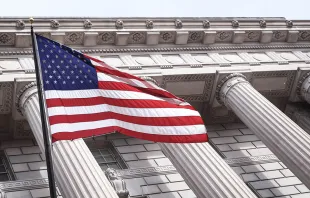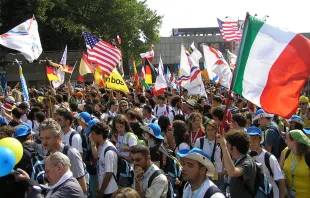Articles by Maureen Ferguson
Developments in Washington
Jan 31, 2020 / 00:00 amOne can be forgiven for thinking all of Washington, D.C., has been consumed by impeachment frenzy these past weeks. Look closer, though, and you’ll see that while Trump administration lawyers have been tied down by the Senate trial, other administration officials have been engaged in a flurry of policy making. These new policies have gone largely unnoticed, but they are of crucial – and positive – importance to all people of faith. The last weeks alone have witnessed sweeping developments on prayer in public schools, discrimination against religious organizations, mandatory abortion coverage in health insurance plans, and government funding of programs encouraging childbirth over abortion. Additionally, the president himself attended the March for Life, and Vice President Pence held a significant meeting with Pope Francis. On school prayer, Education Secretary Betsy DeVos issued guidance clarifying that students do not compromise their right to pray because they attend a public school or university. The DeVos directive also ensures that religious student groups remain on equal footing with secular student groups. This is a critical response to the recent trend of universities’ disallowing any and all religious expression or association at public institutions of higher education. As DeVos stated, "Too many misinterpret a separation of church and state as an invitation for government to separate people from their faith." Public colleges and universities won’t be able to get away with this any longer, thanks to the Trump Administration. The DeVos directive reaffirms the First Amendment right of students to express religious beliefs in their schoolwork as well as to gather to pray at appropriate times. This sends a strong message to school bureaucrats inclined to ban students from praying before high school football games or to defund Christian student groups at public universities. The administration also issued far-reaching rules stating that religious and non-religious charities must be treated equally in the federal grant process. Team Trump has leveled the playing field. Religious charities will now be free to compete for federal grants to serve their fellow Americans. Not only is this a huge win for religious freedom, but it’s also a huge win for the poor and vulnerable. Because, as we know, Catholic and other religious charities are highly regarded as among best in the field of adoption and foster care, caring for victims of human trafficking, providing for the elderly and the poor, and working with refugees and other vulnerable immigrant populations. Nine federal agencies participated in this rule making. The new rule applies across the entire federal government, removing discriminatory regulatory burdens that push religious entities out of the public square – and out of public service. In short, our nation’s social safety net just got stronger. Another significant announcement is that the administration will vigorously enforce the Weldon Amendment, a longstanding law protecting conscience rights. California has been flagrantly violating this law by forcing all health insurance plans in the state, including Catholic health plans, to cover and pay for elective abortions. The U.S. Conference of Catholic Bishops called the policy “abhorrent, unjust and illegal… [a] supreme injustice.” The bishops welcomed the Trump administration’s action as “extraordinarily good news for the right to life, conscientious objection, religious freedom, and the rule of law.” Moreover, the Department of Health and Human Services just came down squarely in support of state healthcare programs that recognize the sanctity of life. Texas had decided years ago that its Medicaid program would support pregnant women and their unborn children, but not abortion-promoting groups like Planned Parenthood. The Obama administration went after Texas but the Trump Administration just granted the necessary waiver supporting Texas’ pro-life policy. That’s all policy, but it’s worth noting again what President Trump and Vice President Pence have been doing themselves. Trump addressed the March for Life rally in person, something no other president has done. Ever. The vice president also spoke to the pro-life March via video from St. Peter’s square at the Vatican, where Pence also had an hour-long private meeting with Pope Francis. The pope and vice president reportedly had a very warm meeting in which they agreed that the cause of life is the “most pressing moral issue of our time.” They also shared their commitment to persecuted Christians and other religious minorities in the Middle East. Pence talked of how proud he is that the United States has partnered with the Knight of Columbus to help rebuild Christian communities once decimated by ISIS in the Nineveh plain. So while the media obsesses over Bolton bombshells and the McConnell vs. Schumer showdown, hardworking policy makers across the administration, empowered by the president to act, have made a significant difference in the lives of people of faith – and the children of God they serve.
Giving thanks for the Church
Nov 21, 2018 / 00:00 amIt’s a great time to be Catholic. I mean that sincerely… in the sense of Dickens’ opening lines in A Tale of Two Cities. “It was the best of times, it was the worst of times… it was the season of light, it was the season of darkness, it was the spring of hope, it was the winter of despair.” The cause for despair is obvious; look no further than last week’s baffling directive from the Vatican to the bishops of the United States to halt their plans to address the scandal surrounding former Cardinal McCarrick and clergy abuse. Perplexing and disheartening. But can it also be the best of times, a springtime of hope? Can only an irrational optimist think so? Reflecting on this past week while the bishops were meeting in Baltimore, the stark contrast between the dysfunction in the hierarchy, and the church I experience every day on the ground as an ordinary lay Catholic, became apparent to me. And I realized all I have to be grateful for in the Church. Looking at a snap shot of my week, while the bishops were stuck in seeming paralysis, I had the privilege of visiting our local Missionaries of Charity soup kitchen to drop off proceeds of a food drive, and enjoyed a delightful visit with the indefatigable Sister Nishi who cheerfully carries on Mother Teresa’s legacy in the Anacostia neighborhood of DC. Later in the week, I was blessed to attend a retreat with the Sisters of Life, who radiate God’s joy and love in a manner that inspires beyond description. Each day, I was fortunate enough to drop off my children at their respective Catholic schools, where they receive a first rate education not only academically, but in virtue and faith. I cannot imagine raising my children in today’s toxic culture without the blessing of these schools, which are run by the prelature of Opus Dei. And each day I was able to receive the Eucharist at my parish from our two dear priests, who carry on selflessly bringing light and hope to our community despite the scandal and tone-deafness of some of their bosses. I am grateful for the many movements within the Church that are vibrant, attractive, beautiful and holy. Just recently, for example, I happened to run into a college friend who is leading a ministry to promulgate the beauty of church teaching on women called ENDOW, and heard from another friend about a new formation program for young women called GIVEN. I could go on and on. Finally, I’m grateful for the domestic church, my family, and the challenges and adventures of family life. I wake up each morning to the sweet chirping of our 7-year old. She came along in my 40’s (we have two in college as well as two teenagers at home). Without the bold proclamation of Humanae Vitae by Pope Saint John Paul II, I would not likely have been open to receiving the gift of our “Catholic Caboose” as we call her. So I’m praying about this season of darkness in our Church, but I am choosing to focus on the light. As C.S. Lewis encouraged us, “Gratitude exclaims, very properly, ‘How good of God to give me this.’”
World Youth Day 25 years later: mercy is still indispensable for all of us
Jul 25, 2016 / 00:00 amExcitement is building in Poland as millions of young people from over 180 countries descend upon Krakow for the celebration of World Youth Day with Pope Francis. I remember well my own eagerness 25 years ago as I packed my bags for World Youth Day, then also in Poland but with Pope John Paul II, and it was an experience that changed the trajectory of my life. Pope John Paul II asked us back in 1991, “How can we fail to be amazed at the heights to which we are called?” The saint had enough confidence in his “dear young people” to call them to a higher vision, a higher ideal than the mediocrity and false ideals that the world presents, indeed he called us to holiness. It was at World Youth Day that I and countless others were inspired to embrace the Church’s beautiful and lofty teachings on the vocation of marriage, resulting years later in the blessing of five precious children who I’m sure wouldn’t be here otherwise, our eldest named John Paul. Pope Francis will offer a similar exhortation to today’s young people, presenting young families at World Youth Day copies of Amoris Laetitia, his apostolic exhortation on love in the family. In a video preview message, Pope Francis said, “The moral and spiritual ‘health’ of a nation is seen in its families. That is why Saint John Paul II showed such great concern for engaged couples, young married couples and families. Continue along this road!” This time, like each World Youth Day before, will no doubt plant the seeds for many new vocations to married and religious life. However, today’s young pilgrims face deeper and stiffer challenges in an increasingly complex and confusing world. Fittingly, the official theme for this year’s World Youth Day is “Blessed are the merciful, for they shall be shown mercy.” In this Jubilee Year of Mercy, the Church’s youth have been called to the nation that gave us the Apostle of Divine Mercy in Saint Faustina Kowalska as well as the man whose zeal for the young originated the very idea that has now turned into the largest gathering of people in the world. Each stop along the way will serve as a reminder to the young pilgrims and the world that mercy is indispensable for all of us, and accepting that mercy is the first step towards conversion. The first stop on Pope Francis’ itinerary is the centuries-old shrine to the Black Madonna in Czestochowa, just as it was for John Paul II’s when I attended 25 years ago. Faith tells us that no one understands our need for mercy better than the Mother of Mercy, but this famous icon perfectly symbolizes that she understands firsthand the misery that war and violence bring. Tradition has it that her image was slashed with swords, and the Virgin appears with sad, iconic eyes and a large scar on her cheek. Poland knows the history and horrors of war and violence all too well, and Pope Francis will draw our attention to this as he visits the Nazi death camps at Auschwitz and Birkenau. Although it is expected Francis will visit these camps in silence, his message of our urgent need for God’s mercy will speak loudly and clearly. He is expected to draw parallels to today’s genocide of Christians and other religious minorities in the Middle East. But the journey doesn’t end with the haunting memories of Auschwitz. It ends in Krakow, Divine Mercy City, where Pope Francis and his young flock of two million or so will reflect on how to obtain mercy. Pope Francis will hear the confessions of pilgrims, visit a children’s hospital, pray at the Shrine of Saint John Paul II, and walk the Way of the Cross. He will celebrate a smaller mass with priests and women religious, seminarians and consecrated women. On the final day, Pope Francis will be joined by millions of young people on the “Field of Mercy” to celebrate mass and in his words, “offer the world a new sign of harmony, a mosaic of different faces, from many races, languages, peoples and cultures, but all united in the name of Jesus, who is the Face of Mercy.” Let’s join our Holy Father in prayer for these pilgrims, who represent the future of the Church and who offer hope to our broken world. For the sake of His sorrowful passion, have mercy on us and on the whole world!
What the Fortnight really meant
Jul 16, 2012 / 00:00 amOn the 4th of July, while most Washingtonians were enjoying cookouts and fireworks, nearly 5,000 Catholics celebrated instead at the closing mass of the “Fortnight for Freedom” at the National Basilica.






